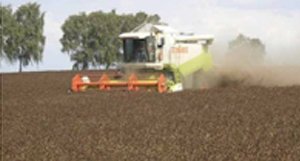 Full
FullGuide »
Bean harvesting dates will depend upon weather, variety and crop location, but spring-sown crops are often earlier to mature than winter ones. Harvesting usually follows winter wheat. The bean crop is less affected by wet weather at harvest than peas.
Bean leaves usually fall during ripening and there are now no desiccants available in field beans. If the crop is very weedy, glyphosate can aid harvesting. It should be applied when at least 90% of pods are dry and black and most seed is dry. Bean pods blacken and seed becomes dry and hard first, but stems usually remain green for longer. Note that glyphosate must not be used on seed crops.
The pods will be easily threshed and the seed fit for combining at 18% moisture content (MC) but, to avoid combine blockages, it is best to wait until only a small percentage of green stem remains. If the seed is very dry, it may be damaged and seed crop quality may be reduced. If the crop is likely to shell out, losses can be reduced if the beans are combined when slightly damp in the early morning or evening.

The quality standard ex-farm is usually 14% MC and 2% impurities, or a combination of the two should not exceed 16%. Merchants may accept beans at 16% MC. Beans must be dried down to 14% MC for long-term storage in bulk. This is important since beans are often stored for some time before they are sold.
The large seed size of beans makes drying difficult as beans have a low resistance to air flow. It takes time to move moisture from the inside to the outside and slow, gentle drying with ambient air is best. Mouldy produce is unacceptable for animal feed or other markets.
Where high quality is important, high temperatures in continuous flow driers should be avoided since they may cause cracking.
Floor ventilated bins are also suitable. When the initial moisture content is high, transfer of beans from bin to bin and the use of warmed air together with adequate ventilation may be necessary to avoid mould developing in the upper layers.
Radially ventilated bins allow faster drying than floor ventilated bins but care must be taken not to overheat the beans.
On-floor drying using ambient or warmed air is also successful, but care must be taken not to load beans too deep if moisture content is high and if lateral ducts are spaced wider than 1m.
Storage in dark areas is recommended for beans destined for the human consumption market in order to delay the development of tannins which cause beans to discolour.